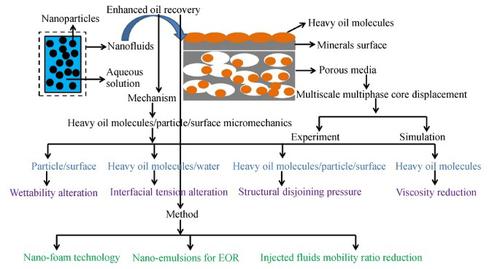Frontiers of Chemical Science and Engineering ( IF 4.3 ) Pub Date : 2022-01-17 , DOI: 10.1007/s11705-021-2120-4 Jinjian Hou 1, 2, 3 , Jinze Du 1, 2 , Hong Sui 1, 2, 3 , Lingyu Sun 1, 2, 3

|
Enhanced oil recovery (EOR) has been widely used to recover residual oil after the primary or secondary oil recovery processes. Compared to conventional methods, chemical EOR has demonstrated high oil recovery and low operational costs. Nanofluids have received extensive attention owing to their advantages of low cost, high oil recovery, and wide applicability. In recent years, nanofluids have been widely used in EOR processes. Moreover, several studies have focused on the role of nanofluids in the nanofluid EOR (N-EOR) process. However, the mechanisms related to N-EOR are unclear, and several of the mechanisms established are chaotic and contradictory. This review was conducted by considering heavy oil molecules/particle/surface micromechanics; nanofluid-assisted EOR methods; multiscale, multiphase pore/core displacement experiments; and multiphase flow fluid-solid coupling simulations. Nanofluids can alter the wettability of minerals (particle/surface micromechanics), oil/water interfacial tension (heavy oil molecules/water micromechanics), and structural disjoining pressure (heavy oil molecules/particle/surface micromechanics). They can also cause viscosity reduction (micromechanics of heavy oil molecules). Nanofoam technology, nanoemulsion technology, and injected fluids were used during the EOR process. The mechanism of N-EOR is based on the nanoparticle adsorption effect. Nanoparticles can be adsorbed on mineral surfaces and alter the wettability of minerals from oil-wet to water-wet conditions. Nanoparticles can also be adsorbed on the oil/water surface, which alters the oil/water interfacial tension, resulting in the formation of emulsions. Asphaltenes are also adsorbed on the surface of nanoparticles, which reduces the asphaltene content in heavy oil, resulting in a decrease in the viscosity of oil, which helps in oil recovery. In previous studies, most researchers only focused on the results, and the nanoparticle adsorption properties have been ignored. This review presents the relationship between the adsorption properties of nanoparticles and the N-EOR mechanisms. The nanofluid behaviour during a multiphase core displacement process is also discussed, and the corresponding simulation is analysed. Finally, potential mechanisms and future directions of N-EOR are proposed. The findings of this study can further the understanding of N-EOR mechanisms from the perspective of heavy oil molecules/particle/surface micromechanics, as well as clarify the role of nanofluids in multiphase core displacement experiments and simulations. This review also presents limitations and bottlenecks, guiding researchers to develop methods to synthesise novel nanoparticles and conduct further research.
中文翻译:

纳米流体在提高采收率中的应用综述
提高采油率 (EOR) 已广泛用于在一次或二次采油过程之后回收剩余油。与传统方法相比,化学 EOR 表现出高采收率和低运营成本。纳米流体由于具有成本低、采收率高、适用性广等优点而受到广泛关注。近年来,纳米流体已广泛用于 EOR 工艺。此外,一些研究集中在纳米流体在纳米流体 EOR (N-EOR) 过程中的作用。然而,与N-EOR相关的机制尚不清楚,所建立的一些机制是混乱和矛盾的。本综述是通过考虑重油分子/颗粒/表面微观力学进行的;纳米流体辅助 EOR 方法;多尺度、多相孔隙/岩心置换实验;和多相流流固耦合模拟。纳米流体可以改变矿物的润湿性(颗粒/表面微力学)、油/水界面张力(重油分子/水微力学)和结构分离压力(重油分子/颗粒/表面微力学)。它们还可能导致粘度降低(重油分子的微观力学)。在 EOR 过程中使用了纳米泡沫技术、纳米乳液技术和注入流体。N-EOR 的机理是基于纳米颗粒的吸附效应。纳米颗粒可以吸附在矿物表面上,并将矿物的润湿性从油湿变为水湿。纳米颗粒还可以吸附在油/水表面,从而改变油/水界面张力,从而形成乳液。沥青质还吸附在纳米颗粒的表面,降低了稠油中的沥青质含量,导致油的粘度降低,有利于采油。在以往的研究中,大多数研究人员只关注结果,而忽略了纳米颗粒的吸附特性。本综述介绍了纳米粒子的吸附特性与 N-EOR 机制之间的关系。还讨论了多相岩心置换过程中的纳米流体行为,并分析了相应的模拟。最后,提出了 N-EOR 的潜在机制和未来方向。本研究结果可以进一步从稠油分子/颗粒/表面微观力学的角度理解N-EOR机理,以及阐明纳米流体在多相岩心位移实验和模拟中的作用。该综述还提出了局限性和瓶颈,指导研究人员开发合成新型纳米颗粒的方法并进行进一步研究。











































 京公网安备 11010802027423号
京公网安备 11010802027423号